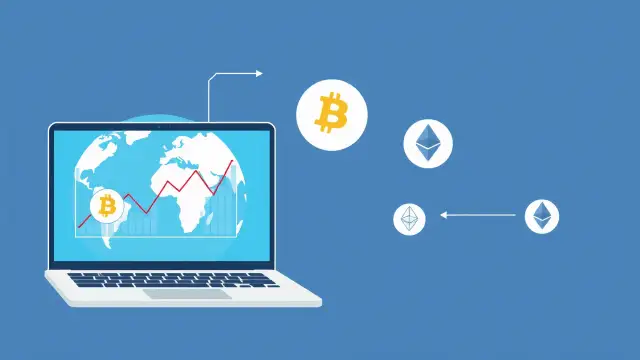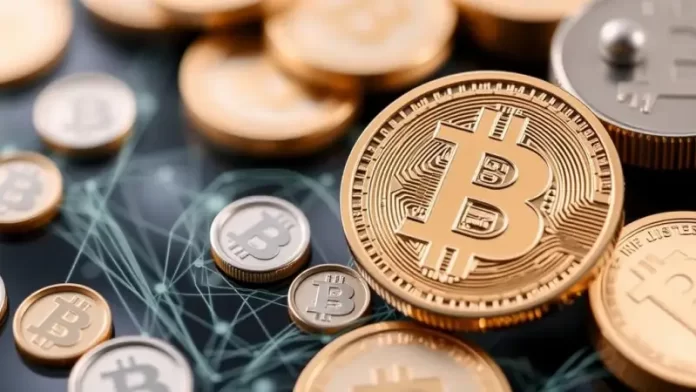Lets dive into the wild world of crypto! Grab a coffee (or tea!), settle in, and lets unravel this digital puzzle together. It might seem like a whole new language at first, but stick with me, and we’ll get you speaking ‘crypto’ in no time.
Table of Contents
What Even is Cryptocurrency? A Beginner’s Deep Dive
Alright, first things first. What is this “cryptocurrency” everyone keeps buzzing about? Think of it like digital or virtual money. But here’s the kicker: unlike the dollars, rupees, or euros in your bank account (which are controlled by governments and banks), most cryptocurrencies are decentralized. What’s that mean? Basically, no single entity like a central bank or government is pulling all the strings.
Instead, cryptocurrencies often rely on a technology called blockchain (we’ll get to that, don’t you worry!), which is managed by a distributed network of computers across the globe. This decentralization is a core feature, making many cryptos resistant to censorship and traditional financial controls. They use cryptography complex coding and encryption techniques to secure transactions and control the creation of new units. It sounds super techy, and well, it is, but the core idea is security and transparency. Imagine digital cash that anyone, anywhere can use, often without needing a bank account. Pretty neat, huh? Its a concept that takes a bit to wrap your head around.

How Does Blockchain Technology Work? Let’s Unpack That Ledger
Okay, so I mentioned blockchain technology. This is the engine running underneath most cryptocurrencies, including the big kahuna, Bitcoin. So, how does it work without making your brain melt?
Imagine a shared, digital ledger like a giant, public Google Sheet that everyone on the network can see, but (and this is crucial) nobody can easily tamper with.
- Blocks: Transactions (like sending crypto from Person A to Person B) are grouped together into “blocks.”
- Chaining: Each new block contains information from the previous block, creating a chronological chain. This chain links all the blocks together, right back to the very first one. Changing any information in an older block would mean redoing all the subsequent blocks, which requires immense computing power and agreement from the network making it incredibly difficult and secure. Its practically immutable.
- Cryptography: Fancy math (cryptographic hashing) secures each block and the links between them. This ensures the data hasn’t been messed with.
- Decentralization: This ledger isn’t stored in one place. It’s copied and spread across thousands, maybe millions, of computers worldwide. So, if one computer goes offline or gets hacked, the network keeps chugging along, validated by the others.
This combination makes blockchain incredibly transparent (most blockchains allow anyone to view transactions, though the identities are usually pseudonymous) and secure. It’s the secret sauce that allows cryptocurrencies to function without a central authority. Trust is built into the system through code and consensus, not intermediaries. Does that makes sense?
Bitcoin, Ethereum, and Altcoins: Spotting the Difference Between Them
You’ve probably heard of Bitcoin (BTC). It’s the original gangster, the first major cryptocurrency, launched back in 2009 by the mysterious Satoshi Nakamoto (still nobody really knows who they are!). Bitcoin’s main goal was to be a peer-to-peer electronic cash system – essentially, digital gold. It’s primarily seen as a store of value and a medium for transactions. Its design are relatively simple compared to newer coins.
Then there’s Ethereum (ETH). Launched later, Ethereum took the blockchain concept and ran with it. Think of Bitcoin like a calculator (does one thing really well) and Ethereum like a smartphone. Ethereum isn’t just about sending value; it allows developers to build decentralized applications (dApps) and smart contracts on its blockchain. Smart contracts are self-executing contracts with the terms of the agreement directly written into code. They automatically run when certain conditions are met. This programmability opened up a whole new world of possibilities: DeFi (Decentralized Finance), NFTs (Non-Fungible Tokens), and more.
So, what about altcoins? “Altcoin” is basically shorthand for “alternative coin” meaning any cryptocurrency that isn’t Bitcoin. And lemme tell you, there are thousands of them. They range from direct competitors trying to improve on Bitcoin or Ethereum, to specialized coins focused on privacy (like Monero), fast transactions, specific industries, or even just internet memes (like Dogecoin or Shiba Inu). The difference between Bitcoin, Ethereum, and altcoins is vast; some altcoins have strong technological foundations and utility, while others are purely speculative or even scams. It’s a jungle out there, so tread carefully! You gotta do your research.
Dipping Your Toes In: How to Buy Cryptocurrency for the First Time
Feeling brave? Ready to get some skin in the game? Buying your first crypto can seem daunting, but it’s gotten way easier over the years. Here’s a general roadmap:
- Choose a Crypto Exchange: These are online platforms where you can buy, sell, and trade cryptocurrencies. Think of them like a stock brokerage, but for crypto. Popular options for beginners include Coinbase, Binance, Kraken, Gemini, or regional ones depending on where you are. Look for exchanges with strong security, reasonable fees, good user reviews, and the specific cryptocurrencies you’re interested in. They all vary slightly.
- Create and Verify Your Account: Just like opening a bank account, you’ll likely need to provide personal information and verify your identity. AML (Anti-Money Laundering) regulations it’s standard practice for legitimate exchanges. This usually involves submitting ID documents.
- Fund Your Account: You need to get traditional money (like USD, EUR, INR) onto the exchange. Common methods include bank transfers (ACH, SEPA, wire), debit cards, or sometimes credit cards (though some card issuers block crypto purchases or treat them as cash advances with hefty fees watch out!). Fees will vary depending on the method.
- Place Your Order: Once your account is funded, navigate to the trading section. Find the cryptocurrency you want to buy (e.g., BTC, ETH). You’ll typically see options like “Market Order” (buy at the current best available price) or “Limit Order” (set a specific price you’re willing to pay). For your first time, a market order is usually simpler. Enter the amount you want to buy (either in fiat currency or crypto amount) and confirm.
- Check Your Wallet: Voila! The crypto should appear in your exchange wallet shortly.
Important Note: While keeping small amounts on a reputable exchange for trading is common, it’s generally not recommended for long-term storage, especially large sums. Why? Because you don’t truly control the keys (we’ll get to keys!). Which brings us to…
Wallets and Safety: Best Crypto Wallets for Beginners & How to Store Cryptocurrency Safely
Okay, you bought some crypto. High five! Now, where should you really keep it? This is where crypto wallets come in, and understanding how to store cryptocurrency safely is maybe the most important part of this whole journey.
Think of a crypto wallet not as a physical wallet holding cash, but as a secure keychain holding the keys that give you access to your funds on the blockchain. The coins themselves always live on the blockchain; the wallet just manages your access.
There are two main types of wallets:
- Hot Wallets: These are connected to the internet.
- Exchange Wallets: The wallet provided by the exchange where you bought the crypto. Convenient for trading, but you don’t control the private keys. If the exchange gets hacked or goes bust, your funds could be at risk. Think “Not your keys, not your coins.”
- Software Wallets: Apps you install on your phone (e.g., Trust Wallet, Exodus) or computer (e.g., Electrum, Exodus Desktop). You typically control your private keys (huge plus!), but they are still vulnerable if your device gets malware. Generally considered safer than exchange wallets for holding. Many are great options among the best crypto wallets for beginners due to their user-friendliness. They’re good for smaller amounts you might want to access easily.
- Cold Wallets (Cold Storage): These are not connected to the internet, making them much more secure against online threats.
- Hardware Wallets: Physical devices (like a USB stick, e.g., Ledger Nano S/X, Trezor Model T) that store your private keys offline. Transactions are signed on the device itself, so the keys never touch your internet-connected computer. This is widely considered the gold standard for how to store cryptocurrency safely, especially for significant amounts or long-term holding. There’s a learning curve, but it’s worth it.
- Paper Wallets: Literally printing your public and private keys onto paper. Very secure if done correctly and stored safely (fireproof, waterproof safe!), but cumbersome and prone to physical damage or loss. Less common nowadays.
The best approach often involves using both: a hardware wallet for your main stash (long-term holds) and maybe a software wallet for smaller, day-to-day amounts. Never keep large amounts on an exchange long-term! Its just asking for trouble.
Keys to the Kingdom: What are Private and Public Keys?
We’ve mentioned keys a lot. So, what are private and public keys? They are fundamental to how crypto works and how you control your assets.
- Public Key: Think of this like your email address or your bank account number. It’s derived from your private key, and you can safely share it with others. People use your public address (a shorter, often hashed version of your public key) to send cryptocurrency to you. Sharing your public key/address is necessary and safe.
- Private Key: This is the secret sauce. Think of it like the password to your email or the PIN for your bank card, but way more critical. Your private key proves you own the crypto associated with your public address and gives you the authority to spend or send it. You must NEVER share your private key with anyone. If someone gets your private key, they have full control over your crypto. Gone forever. No backsies.
Seed Phrase (Recovery Phrase): When you set up most non-exchange wallets (software or hardware), you’ll be given a seed phrase – typically 12 or 24 random words. This phrase is essentially a backup of your private keys. If you lose your wallet device (phone breaks, hardware wallet lost), you can use this seed phrase to restore access to your funds on a new device. Guard this seed phrase with your life. Write it down (don’t store it digitally!), make multiple copies, and store them securely in different physical locations.
Do not take a photo of it! Do not email it to yourself! Treat it like hidden treasure. Losing your seed phrase and access to your wallet means your crypto is likely lost forever. Seriously.
Phew! That was a lot, wasn’t it? We’ve gone from “What is crypto?” to the nitty-gritty of blockchain, different coin types, buying your first digital asset, and the crucial steps of storing it safely using wallets and understanding your keys.
The world of cryptocurrency is exciting, innovative, and yes, sometimes volatile and complex. It’s constantly evolving. This guide is just the starting point on your journey. Keep learning, stay curious, always prioritize security (remember: Not your keys, not your coins!), and never invest more than you can comfortably afford to lose. Welcome down the rabbit hole!

